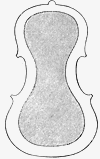The Model
When we speak of models in lutherie, we refer to the outline, arch, fhole design, and overall dimensions and stylistic traits of a particular violin, viola, or cello. While models historically have been the byproduct of historical innovation, dynastic making traditions, and the idiosyncratic choices of individual makers, today we employ different models to achieve different tonal and aesthetic results.
As a contemporary maker, I make a range historical models, yet in parallel I have developed my own models that recognize the successful traits of historical models while allowing me freedom to push the tone and appearance of the instrument in a direction that is authentic to my personality as a maker.
The choice of one model over another will have an important influence on the how the instrument behaves tonally and in terms of its playability. For example, a smaller Rogeri model cello, with a shorter body and shorter body length might be a better choice for a smaller cellist than a larger early Stradivari model. A violinist seeking a darker, growling tone, might be better off choosing a model by Giuseppe Guarneri over a model by Nicolò Amati.
Questions concerning which model is best for you is very personal, and it is a topic that I like to discuss in depth with musicians considering having a new instrument made for them. Choosing the right model will increase the chances that you love the tone and feel of your new instrument.
As a contemporary maker, I make a range historical models, yet in parallel I have developed my own models that recognize the successful traits of historical models while allowing me freedom to push the tone and appearance of the instrument in a direction that is authentic to my personality as a maker.
The choice of one model over another will have an important influence on the how the instrument behaves tonally and in terms of its playability. For example, a smaller Rogeri model cello, with a shorter body and shorter body length might be a better choice for a smaller cellist than a larger early Stradivari model. A violinist seeking a darker, growling tone, might be better off choosing a model by Giuseppe Guarneri over a model by Nicolò Amati.
Questions concerning which model is best for you is very personal, and it is a topic that I like to discuss in depth with musicians considering having a new instrument made for them. Choosing the right model will increase the chances that you love the tone and feel of your new instrument.

